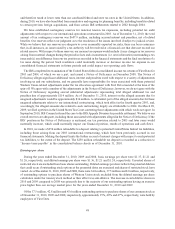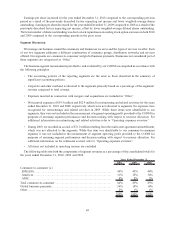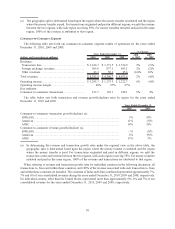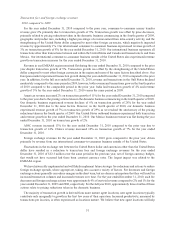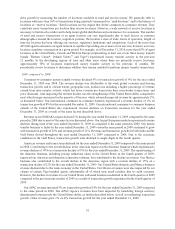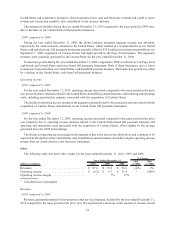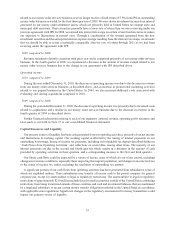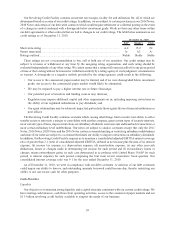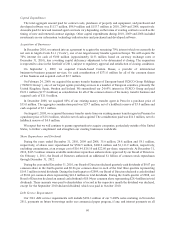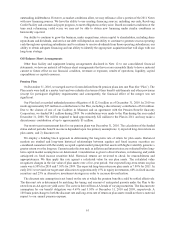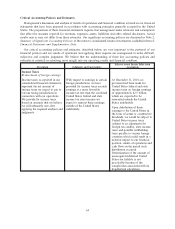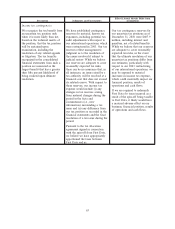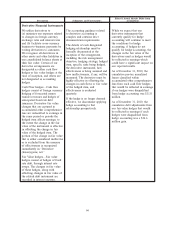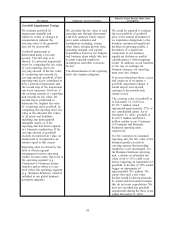Western Union 2010 Annual Report Download - page 60
Download and view the complete annual report
Please find page 60 of the 2010 Western Union annual report below. You can navigate through the pages in the report by either clicking on the pages listed below, or by using the keyword search tool below to find specific information within the annual report.Interest due under the Revolving Credit Facility is fixed for the term of each borrowing and is payable according
to the terms of that borrowing. Generally, interest is calculated using a selected LIBOR rate plus an interest rate
margin of 19 basis points. A facility fee of 6 basis points on the total facility is payable quarterly regardless of usage.
The facility fee percentage is determined based on certain of our credit ratings. In addition, to the extent the
aggregate outstanding borrowings under the Revolving Credit Facility exceed 50% of the related aggregate
commitments, a utilization fee of 5 basis points as of December 31, 2010 based upon such ratings is payable to the
lenders on the aggregate outstanding borrowings. The interest rate margin, facility fee and utilization fee are all
based on certain of our credit ratings.
As of and during the year ended December 31, 2010, we had no outstanding borrowings on this facility and had
$1.5 billion available to borrow. Our revolving credit facility, which is diversified through a group of 15
participating institutions, is used to provide general liquidity for us and to support our commercial paper
program, which we believe enhances our short term credit rating. The largest commitment from any single
financial institution within the total committed balance of $1.5 billion is approximately 20%. The substantial
majority of the banks within this group were rated at least an “A⫺” or better as of December 31, 2010. If the amount
available to borrow under the revolving credit facility decreased, or if the revolving credit facility were eliminated,
the cost and availability of borrowing under the commercial paper program may be impacted.
Notes
On June 21, 2010, we issued $250 million of aggregate principal amount of unsecured notes due June 21, 2040.
Interest with respect to the 2040 Notes is payable semiannually on June 21 and December 21 each year based on the
fixed per annum interest rate of 6.200%. We may redeem the 2040 Notes at any time prior to maturity at the greater
of par or a price based on the applicable treasury rate plus 30 basis points.
On March 30, 2010, we exchanged $303.7 million of aggregate principal amount of our 2011 Notes for
unsecured notes due April 1, 2020. Interest with respect to the 2020 Notes is payable semiannually on April 1 and
October 1 each year based on the fixed per annum interest rate of 5.253%. In connection with the exchange, note
holders were given a 7% premium ($21.2 million), which approximated market value at the exchange date, as
additional principal. As this transaction was accounted for as a debt modification, this premium was not charged to
expense. Rather, the premium, along with the offsetting hedge accounting adjustments, will be accreted into interest
expense over the life of the notes. We may redeem the 2020 Notes at any time prior to maturity at the greater of par or
a price based on the applicable treasury rate plus 15 basis points.
On February 26, 2009, we issued $500 million of aggregate principal amount of our 2014 Notes. Interest with
respect to the 2014 Notes is payable semiannually on February 26 and August 26 each year based on the fixed per
annum interest rate of 6.500%. We may redeem the 2014 Notes at any time prior to maturity at the greater of par or a
price based on the applicable treasury rate plus 50 basis points.
On November 17, 2006, we issued $1 billion aggregate principal amount of 5.400% Notes due 2011 and
$500 million aggregate principal amount of 6.200% Notes due 2036 (the “2036 Notes”). Interest with respect to the
2011 Notes and 2036 Notes is payable semiannually on May 17 and November 17 each year based on fixed per
annum interest rates of 5.400% and 6.200%, respectively. We may redeem the 2011 Notes and the 2036 Notes at any
time prior to maturity at the greater of par or a price based on the applicable treasury rate plus 15 basis points and
25 basis points, respectively.
On September 29, 2006, we issued $1 billion of aggregate principal amount of unsecured notes maturing on
October 1, 2016. Interest on the 2016 Notes is payable semiannually on April 1 and October 1 each year based on a
fixed per annum interest rate of 5.930%. We may redeem the 2016 Notes at any time prior to maturity at the greater
of par or a price based on the applicable treasury rate plus 20 basis points.
Credit Ratings and Debt Covenants
The credit ratings on our debt are an important consideration in managing our financing costs and facilitating
access to additional capital on favorable terms. Factors that we believe are important in assessing our credit ratings
include earnings, cash flow generation, leverage, available liquidity and overall business risks.
58


